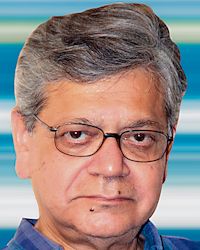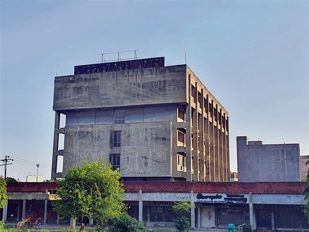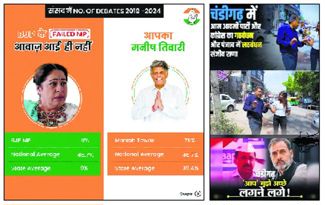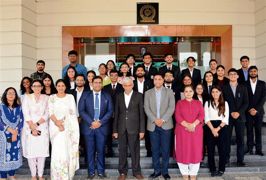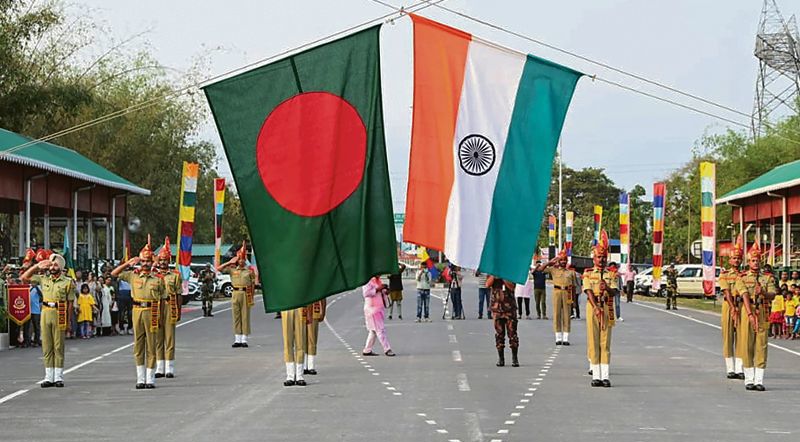
Ground reality: India is outranked by Bangladesh in the ‘medium human development’ group. PTI
Senior Economic Analyst
INDIA has set itself the goal of becoming a developed country in around a quarter century (by 2047). In order to treat that as a seriously considered agenda and not just an election talking point to be forgotten after polling, the country must realise what lies ahead.
First, it is not enough to achieve a high level of national income which goes with a high per capita income. The fruits of this income must be distributed widely, leading to all-round development, and be reflected in very high scores in the United Nations Development Programme’s (UNDP’s) human development indicators. Currently in India, there is a high level of inequality, with multiple billionaires and a demand for high-end cars on the one hand, and continuing widespread poverty with a high demand for guaranteed low-wage rural work simply to keep body and soul together.
If joining the league of developed nations is the ultimate goal, India must begin with doing better than its equals. How does India stand in relation to its regional neighbours who share a good bit of the same geography and history by being under the rule of the same colonial power? The answer is hugely disappointing.
According to the UNDP classification, the table of nations is headed by the ‘very high human development’ group (led by Switzerland and Norway), followed by the ‘high human development’ group, which includes China and Sri Lanka. India does not make it to this club, but is present in the ‘medium human development’ group where, significantly, it is outranked by Bhutan and Bangladesh, but is ahead of Nepal. The saving grace is that Pakistan makes it only to the next group, titled ‘low human development’.
This ranking is derived from the score a country achieves on the human development index (Human Development Report 2023-24). A look at individual indicators that make up the index gives us a more nuanced picture. In life expectancy of both men and women, Bangladesh and Nepal are ahead of India, not to speak of Sri Lanka, which tops the regional list. In per capita income, it is the same story, but the differences between men and women are worth noting. Significantly, women in Bangladesh earn more than their Indian counterparts, but men in the neighbouring country earn less than Indian men. Also, Indian men earn over three times more than women, but Bangladesh men earn less than three times more than women.
This would indicate that the social system in Bangladesh is supportive of women and helps them earn more. Bangladeshi women earn more in part because they are better skilled, having received more mean years of schooling — 6.8 years versus 5.5 in India. The overall status of women is captured in the gender development index, in which Sri Lanka leads (with a score of 0.947), followed by Bangladesh (0.914) and Nepal (0.885). Then come India (with 0.852) and Nepal (0.885) and lastly Pakistan (0.834).
Bare statistics do not tell the human story that underlines the development exercise. A great amount of anecdotal evidence is contained in a recent book, Unequal: Why India Lags Behind Its Neighbours, by Swati Narayan. She writes about a lower-caste (Dom) family in north Bihar that has gathered to mourn the death of a relative, who was afflicted by cirrhosis of the liver, brought on by drinking illicit liquor (the state is officially dry).
What was immediately striking to her was the difference in appearance and demeanour of family members from Bihar and a young couple which had just crossed over from Nepal through the open border to attend the rituals. The young couple was upwardly mobile and in good health. The woman had gone to a free government school till Class VIII, and when her baby fell ill, she took her to a nearby government clinic for prompt and free treatment. The author’s research showed that there had been a distinct improvement in caste and gender relations in Nepal since democracy returned in 2006.
On the other hand, those who were living in India (a family elder having migrated from Nepal two decades ago) complained about the caste discrimination their children faced in school. They were petrified at the thought of a family member falling ill, as in this Bihar hinterland there were no health centres where free medicines were available. The travails of people living in the area bordering Nepal reached a peak when the border was closed during the Covid-19 pandemic, preventing them from going across for medical treatment, which was better and cheaper.
Narayan’s five-year research was focused on finding out why there was such a difference in the quality of healthcare, education and life chances between India and its poorer neighbours like Nepal and Bangladesh. The answer lies in the extreme inequalities in class, caste and gender that still prevail in India. Her conclusion is that unless these inequalities are breached, it will be “impossible for the nation as a whole to prosper, let alone be a world leader”.
The government has till now focused on providing free food to the poor, jobs through an extensive rural employment guarantee programme, helping construct toilets so as to end open defecation, and access to electricity everywhere. All this is fine, but there is a need to lay stress on changing social attitudes. The number of women in senior management positions and corporate boards is increasing, but a huge proportion of rural women (80 per cent, according to a 2019 study) are engaged in unpaid domestic work.
Changing social attitudes is the job of social leaders. Economists are pointing out that a good start would be to intensify efforts to improve farm technology. Once agricultural productivity rises rapidly, farm incomes will follow suit. Many will leave farms to join in the delivery of rural services (sale and maintenance of cellphones, motorbikes and TV sets) and the migration of villagers to urban areas in search of jobs will lessen. Scientists delivered India’s first Green Revolution. It’s high time they delivered the second one, riding on the millet bandwagon.
Join Whatsapp Channel of The Tribune for latest updates.






